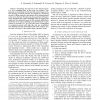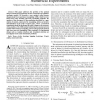165 search results - page 26 / 33 » Teaching Randomized Learners |
ICML
2006
IEEE
14 years 8 months ago
2006
IEEE
I consider the setting of transductive learning of vertex labels in graphs, in which a graph with n vertices is sampled according to some unknown distribution; there is a true lab...
ICML
2004
IEEE
14 years 8 months ago
2004
IEEE
This paper extends previous work on the Skewing algorithm, a promising approach that allows greedy decision tree induction algorithms to handle problematic functions such as parit...
IJCNN
2007
IEEE
14 years 2 months ago
2007
IEEE
— Forecasting the tide level in the Venezia lagoon is a very compelling task. In this work we propose a new approach to the learning of tide level time series based on the local ...
TNN
2008
13 years 7 months ago
2008
This paper addresses the problem of the optimal design of numerical experiments for the construction of nonlinear surrogate models. We describe a new method, called learner disagre...
TAL
2010
Springer
13 years 6 months ago
2010
Springer
Mihalcea [1] discusses self-training and co-training in the context of word sense disambiguation and shows that parameter optimization on individual words was important to obtain g...


